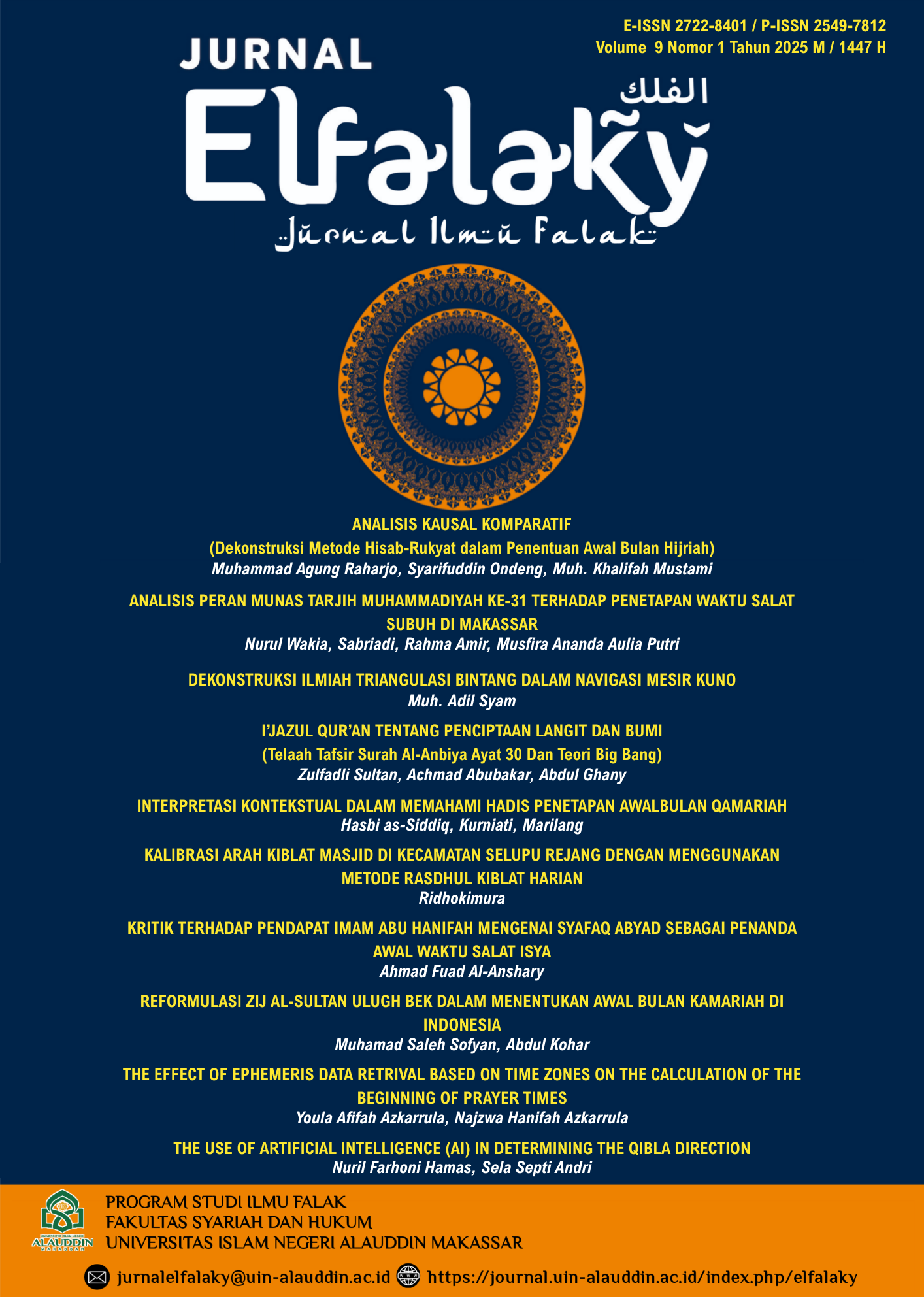THE USE OF ARTIFICIAL INTELLIGENCE (AI) IN DETERMINING THE QIBLA DIRECTION
DOI:
https://doi.org/10.24252/ifk.v9i1.55375Keywords:
Natural Language Processing, Artificial Intelligence, Qibla DirectionAbstract
Facing the Qibla is one of the prerequisites for valid prayer. The methods of determining the Qibla direction have been extensively explored, ranging from simple methods to using highly advanced technology. The emergence of Artificial Intelligence (AI) technology, which is currently evolving, is designed to address various issues, including the Qibla direction. One of the evolving models is Natural Language Processing (NLP), which enables computers to understand human natural language. Even when given questions about the Qibla direction of a place, AI can respond with the azimuth value according to the desired city input by the user. The aim of this paper is to examine how the use of artificial intelligence (AI) in determining the Qibla direction, and to determine the accuracy of the Qibla direction produced by Artificial Intelligence. The method used in this research is a qualitative method with an experimental approach, which is used to investigate the influence of certain treatments on others under controlled conditions. In this case, primary data sources are taken from artificial intelligence given keywords (prompts) to obtain the Qibla direction of a city. Then, the results of the Qibla direction from the artificial intelligence machine (AI) are analyzed based on fiqh (Islamic jurisprudence) and astronomical principles. The results of this study indicate that there is artificial intelligence that produces accurate calculations of the direction of the Qibla, namely ChatGPT, while others are still not completely accurate because the answers produced by the artificial intelligence have not applied mathematical principles in their calculations so that they cannot be relied on as a guideline in determining the direction of the Qibla. Therefore, further development is needed in the use of artificial intelligence (AI) in determining the direction of the Qibla.
References
Arifin, Zainul. “Akurasi Google Earth Dalam Pengukuran Arah Kiblat.” Jurnal Ulumuddin 7, no. 2 (2017).
Awwalany, Nur Afny, Sippah Chotban, and Subhan Khalik. “Peluang Dan Tantangan Ilmu Falak Di Indonesia Era Digital.” Hisabuna 4, no. 3 (2023).
Budiharto, Widodo, and Derwin Suhartono. Artificial Intelligence Konsep Dan Penerapannya. Yogjakarta: Andi Offset, 2014.
Cucus, A., R. Y. Endra, and T. Naralita. “Chatter Bot Untuk Konsultasi Akademik Di Perguruan Tinggi.” Explore: Jurnal Sistem Informasi Dan Telematika (Telekomunikasi, Multimedia Dan Informatika) 10, no. 1 (2019).
Eriana, Emi Sita, and Afrizal Zein. Artificial Intelligence (AI). Purbalingga: Eureka Media Aksara, 2023.
Faid, Muhammad Syazwan, Muhammad Syaoqi Nahwandi, Mohd Saiful Anwar Bin Mohd Nawawi, Nurul Huda Binti Ahmad Zaki, and Mohd Hafiz Mohd Saadon. “Development of Qibla Direction Determinant Using Sun Shadow.” Online Journal of Research in Islamic Studies 9, no. 1 (2022).
Hambali, Slamet. “Menguji Tingkat Keakuratan Hasil Pengukuraan Arah Kiblat Menggunakan Istiwaaini Karya Slamet Hambali.” Semarang, 2014.
Jassim, Mohammed, Ahmed Al-Talabany, and Mohammed Mohammed. “Novel (RDQ) Method for Precise Qibla Determination Using GNSS Built in a Computer Software.” ZANCO Journal of Pure and Applied Science 28 (2016).
Lukman, Riska Agustina, and Rihadatul Aisy. “Problematika Penggunaan Artificial Intelligence (AI) Untuk Pembelajaran Di Kalangan Mahasiswa STIT Pemalang.” Jurnal Madaniyah 13, no. 2 (2023).
Mustaqim, Riza Aftian. “Penggunaan Google Earth Sebagai Calibrator Arah Kiblat.” Jurnal Justisia 6, no. 2 (2021).
Salim, Ardiansyah. Birokrasi 4.0: Penerapan Artificial Intelligence. Depok: Rajawali Pers, 2021.
Thomas Djamaluddin. “Penentuan Arah Kiblat.” Dokumentasi T.Djamaluddin Berbagi Ilmu untuk Pencerahan dan Inspirasi, 2024.









